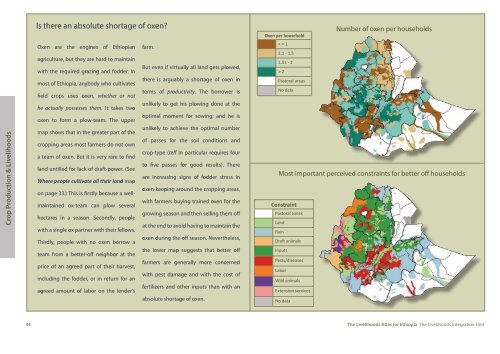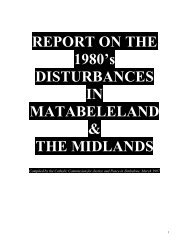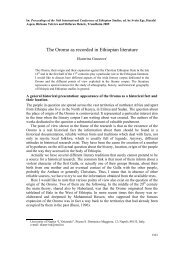Atlas Final Web Version 6_14
Atlas Final Web Version 6_14
Atlas Final Web Version 6_14
Create successful ePaper yourself
Turn your PDF publications into a flip-book with our unique Google optimized e-Paper software.
Crop Production & Livelihoods<br />
Is there an absolute shortage of oxen?<br />
Oxen are the engines of Ethiopian farm.<br />
agriculture, but they are hard to maintain<br />
with the required grazing and fodder. In<br />
most of Ethiopia, anybody who cultivates<br />
field crops uses oxen, whether or not<br />
he actually possesses them. It takes two<br />
oxen to form a plow-team. The upper<br />
map shows that in the greater part of the<br />
cropping areas most farmers do not own<br />
a team of oxen. But it is very rare to find<br />
land untilled for lack of draft-power. (See<br />
Where people cultivate all their land map<br />
on page 33.) This is firstly because a wellmaintained<br />
ox-team can plow several<br />
hectares in a season. Secondly, people<br />
with a single ox partner with their fellows.<br />
Thirdly, people with no oxen borrow a<br />
team from a better-off neighbor at the<br />
price of an agreed part of their harvest,<br />
including the fodder, or in return for an<br />
agreed amount of labor on the lender’s<br />
But even if virtually all land gets plowed,<br />
there is arguably a shortage of oxen in<br />
terms of productivity. The borrower is<br />
unlikely to get his plowing done at the<br />
optimal moment for sowing; and he is<br />
unlikely to achieve the optimal number<br />
of passes for the soil conditions and<br />
crop-type (teff in particular requires four<br />
to five passes for good results). There<br />
are increasing signs of fodder stress in<br />
oxen-keeping around the cropping areas,<br />
with farmers buying trained oxen for the<br />
growing season and then selling them off<br />
at the end to avoid having to maintain the<br />
oxen during the off season. Nevertheless,<br />
the lower map suggests that better off<br />
farmers are generally more concerned<br />
with pest damage and with the cost of<br />
fertilizers and other inputs than with an<br />
absolute shortage of oxen.<br />
Oxen per household<br />
< = 1<br />
1.1 - 1.5<br />
1.51 - 2<br />
> 2<br />
Pastoral areas<br />
No data<br />
Number of oxen per households<br />
Most important perceived constraints for better off households<br />
Constraint<br />
Pastoral zones<br />
Land<br />
Rain<br />
Draft animals<br />
Inputs<br />
Pests/diseases<br />
Labor<br />
Wild animals<br />
Extension services<br />
No data<br />
34 The Livelihoods <strong>Atlas</strong> for Ethiopia The Livelihoods Integration Unit







